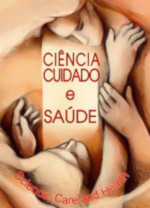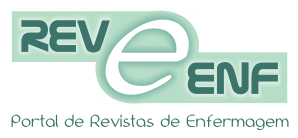Educational technology for people using insulin
Abstract
Objective: To build and validate a printed, flipchart-type, educational technology to support educational actions performed by health professionals for people with diabetes using insulin. Method: Methodological study comprising three steps: in the first, was defined the bibliographic reference for the construction of the flipchart; in the second, the educational technology was built; in the third, the flipchart was validated by the target audience and expert judges. The technology was submitted to the appreciation of ten target audience participants and ten judges during the validation process. A data collection instrument addressing criteria related to organization, writing style, appearance and motivation was applied to the target audience, and addressing appearance and content to expert judges. The Content Validation Index (CVI) was applied to data. An agreement index of 0.90 was considered for the flipchart validation. Result: The global CVI was 1.0 for the target audience and 0.98 for the expert judges. Final considerations: The objective of building and validating an educational technology considered suitable for use by its evaluators was achieved in the study. The conclusion is that the flipchart is a tool of great potential in health education for people with diabetes in use of insulin.
Downloads
References
Sociedade Brasileira de Diabetes. Diretrizes da Sociedade Brasileira de Diabetes 2017-2018. São Paulo: Editora Clannad. [On-line] 2017. [citado em 8 fev 2020]. Disponível em URL: https://www.diabetes.org.br/profissionais/images/2017/diretrizes/diretrizes-sbd-2017-2018.pdf
Flor LS, Campos MR. The prevalence of diabetes mellitus and its associated factors in the Brazilian adult population: evidence from a population-based survey. Rev. Bras. Epidemiol. 2017; 20(1):16-29. Doi:http://dx.doi.org/10.1590/1980-5497201700010002.
Salbego C, Nietsche EA, Teixeira E, Girardon-Perlini NMO, Wild CF, Ilha S. Care-educational technologies: an emerging concept of the praxis of nurses in a hospital context. Rev. Bras. Enferm. 2018; 71(Suppl 6): 2666-2674. Doi: http://dx.doi.org/10.1590/0034-7167-2017-0753.
Moura DD, Moura ND, Menezes LC, Barros AA, Guedes MV. Development of a booklet on insulin therapy for children with diabetes mellitus type 1. Rev. Bras. Enferm. 2017; 70 (1): 07-14. Doi: https://doi.org/10.1590/0034-7167-2016-0183.
Marques CR. Percepção dos usuários insulino dependentes não controlados quanto ao tratamento para o diabetes mellitus tipo 2. Rev. APS. 2017 jan/mar; 20 (1): 69-80. Doi: https://doi.org/10.34019/1809-8363.2017.v20.15702.
Dalmolin A, Girardon-Perlini NMO, Coppetti LC, Rossato GC, Gomes JS, Silma MEN. Educational video as a healthcare education resource for people with colostomy and their families. Rev. Gaúcha Enferm . 2016; 37(Spe):e68373. Doi: http://dx.doi.org/10.1590/1983-1447.2016.esp.68373
Polit DF, Beck CT. Fundamentos de Pesquisa em Enfermagem: avaliação de evidências para as práticas da enfermagem. 7ª ed. Porto Alegre: Artmed: 2011.
Polit DF, Beck CT, Owen SV. Is the CVI an acceptable indicator of content validity? Appraisal and recommendations. Research in Nursing and Health. 2007; 30(4): 459-467. Doi: https://doi.org/10.1002/nur.20199.
Alexandre NMC, Coluci MZO. Validade de conteúdo nos processos de construção e adaptação de instrumentos de medidas. Ciênc. saúde coletiva . 2011 Jul; 16(7): 3061-3068. Doi:http://dx.doi.org/10.1590/S1413-81232011000800006.
Oliveira MS, Fernandes AFC, Sawada NO. Manual educativo para o autocuidado da mulher mastectomizada: um estudo de validação. Texto contexto - enferm . 2008 Mar; 17( 1 ): 115-123. Doi: http://dx.doi.org/10.1590/S0104-07072008000100013.
Rosa BVC da, Girardon-Perlini NMO, Gamboa NSG, Nietsche EA, Beuter MDA. Development and validation audiovisual educational technology for families and people with colostomy by cancer. Texto contexto - enferm. 2019 Jul; 28: e20180053. Doi:https://doi.org/10.1590/1980-265x-tce-2018-0053.
Echer IC. The development of handbooks of health care guidelines. Rev. Latino-Am. Enferm. 2005; 13(5):754-7. Doi: https://doi.org/10.1590/S0104-11692005000500022.
Nakamura MY, Almeida K de. Desenvolvimento de material educacional para orientação de idosos candidatos ao uso de próteses auditivas. Audiol, Commun. Res . 2018 Dez ; 23: e1938. Doi:http://dx.doi.org/10.1590/2317-6431-2017-1938.
Sena JF. Construção e validação de tecnologia educativa para o cuidado de pessoas com estomia intestinal. 2017.[dissertação]. Natal (RN).Mestrado em Enfermagem.Universidade Federal do Rio Grande do Norte – UFRN. 2017.
Santos ROMdos, Ramos DN, de Assis M. Construção compartilhada de material educativo sobre câncer de próstata. Rev. Panam. SaludPublica 2019 Jan; 42:e122. Doi:https://doi.org/10.26633/RPSP.2018.122.
Moreschi C, Rempel C, Backes DS, Pombo CNF, Siqueira DF, Pissaia LF. Actions of fhs teams for the quality of life of people with diabetes. Cienc. Cuid. Saude. 2018 Apr/Jun; 17(2): 1-8. Doi: https://doi.org/10.4025/cienccuidsaude.v17i2.41000.
Barbosa EMG, Sousa AAS, Vasconcelos MGF, Carvalho REFL, Oriá MOB, Rodrigues DP. Educational technologies to encourage (self) care in postpartum women. Rev. Bras. Enferm. 2016; 69(3):545-53. Doi: http://dx.doi.org/10.1590/0034-7167.2016690323i.
Copyright (c) 2020 Ciência, Cuidado e Saúde

This work is licensed under a Creative Commons Attribution-NonCommercial 4.0 International License.





















